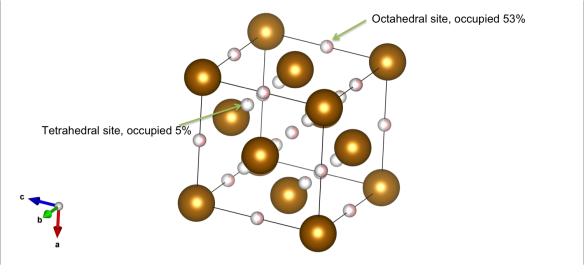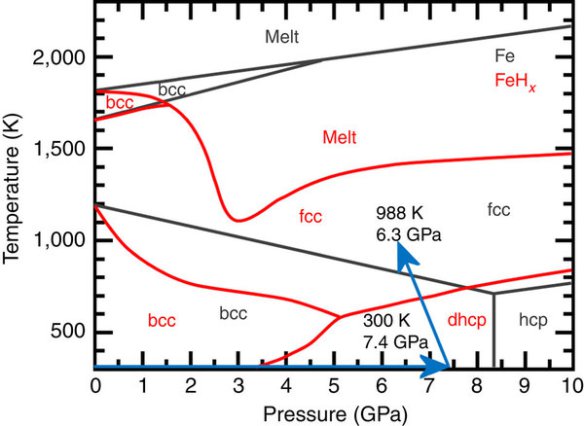Finding hydrogen – where does it sit in fcc Iron hydride?
What does it look like?

FCC Iron hydride. The orange atoms are the iron positions and the pink atoms are the deuterium positions. Image generated by the VESTA (Visualisation for Electronic and STructural analysis) software http://jp-minerals.org/vesta/en/
What is it?
Even the smallest element can have a big effect on the properties of a metal. This is definitely the case when you add hydrogen to iron. Even in small amounts, it can massively alter the melting temperature with pressure.

Black lines show the phase diagram of pure iron, and the red lines show the transitions in iron hydride (FeHx). Image taken from the Machida et al. paper http://www.nature.com/ncomms/2014/140926/ncomms6063/full/ncomms6063.html
One key to understanding this effect is to understand where exactly the hydrogen atoms sit within the arrangement of iron atoms, and indeed even how many of them there are! (Hence the 'x' in the chemical formula). The focus of a recent study has been to study the face centred cubic (fcc) phase of FeHx. In this form, which only exists at high-pressures and temperatures, the iron atoms are arranged in the same structure as gold.
The best technique to find the hydrogen positions is with neutron diffraction, as we've explained before, with the only difference being that you need to substitute hydrogen with heavy hydrogen (deuterium). But then to create pressures and temperatures in a sample big enough required the use of a multi-ton press. So this experiment was conducted at the PLANET beamline at the Materials and Life science Facility in Japan, where as well as one of the highest powered neutron beams in the world, they have a press capable of generating 500 tons!
They discovered that the diffraction pattern of the fcc iron hydride they formed at 988 K and 6.3 GPa could best be described by placing a deuterium atom at both the 'octahedral' and 'tetrahedral' positions in the structure – which was something that hadn't been realised before. However, the occupancy of the 'tetrahedral' site is very little (there's an atom there only 5% of the time).
Where did the structure come from?
This structure for FeDx, determined by Machida et al., was very recently published in Nature Communications. It's an open access article that you can read here.






